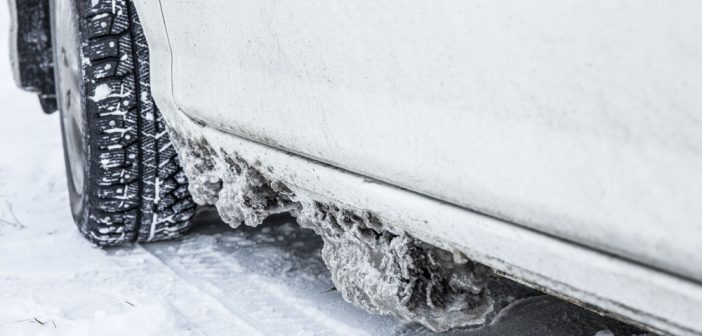A huge storm that’s targeting your area will probably have some snowy conditions with it. Winter weather poses many challenges to drivers as they go about their daily lives. An issue that arises during this season is dealing with road salt. It may be a saving grace for safe roadways, but it can create extensive damage to your vehicle. Learn how you can protect your car from road salt with these tips.
Wash it Regularly
It’s difficult to prioritize car washes in the winter. Rain and snow are perpetual companions. However, take advantage of any clear day to wash away debris and road salt from the exterior.
Choose a day with 40-degree Fahrenheit temperatures or higher. Rinse off the car, and scrub it with an appropriate detergent. Steer clear of any dish-washing fluids, however. They aren’t conducive to a protected paint job.
Don’t wait for more than 10 days to wash the car. This time frame gives road salt a chance to work its way into the vehicle’s crevices. Consider a weekly washing if possible.
Become a Waxing Fan
Protecting your car from road salt is incredibly easy when wax is regularly applied to the vehicle. Wax certainly gives the car a shiny appearance, and it also creates a film. This layer protects the paint from salt exposure. Any damage that the salt might do to the car is now working on the wax layer.
The key to paint protection is keeping up with the waxing process. It should be reapplied once or twice each winter season, depending on how often the car is exposed to road salt.
Focus on Salt Stains
Washing and waxing your car may not be enough. In fact, there might be salt stains on the paint even after a thorough wash. Think about adding baking soda to your rinsing water as an effective way to remove those stains. Salts are chemically reacting on the paint, which leads to permanent damage over time. Those stains can be fought off with the baking soda’s addition. Wash and rinse the car in a well-lit area so that you can see all of the stains as you work the baking soda into their locations.
Scrub the Wheels
Your wheels are just as vulnerable to road salt as the rest of the car. As you wash and wax the car, be sure to concentrate on the wheels. Scrub away any debris with a brush or rag. Use a powerful water jet to clean off the crevices around the tire.
Rust can easily start around the wheels, especially if they aren’t prioritized during your washing efforts. Although it may be tough, try to dry all of the crevices before parking the car. You’ll prolong the wheels’ lifespan with this strategy.
Don’t Overlook the Undercarriage
An area that’s often overlooked is the undercarriage. Washing the car at home means that runoff from your efforts will only partially clean this area. Try to aim your garden hose under the car. Allow the water to sheet the undercarriage and fall away from the parts.
If you have a particularly dirty vehicle, take it to a commercial car wash for the sole purpose of cleaning the undercarriage. These facilities usually have a dedicated section where water jets onto the undercarriage. Road salt is no match for these cleaning solutions.
Dry Off the Smallest Crevices
Don’t just wash and rinse the vehicle. Remember that drying it off is just as important. Take a large rag to the vehicle’s exterior. Wipe off every surface, including the smallest crevices. These areas can house road salt because of their hidden locations. Allowing the salt to fester in these areas will only lead to damage.
Taking the vehicle through a commercial car wash with dryers won’t have the same effect either. Those dryers focus on water evaporation instead of wiping away trapped salt. Wash, rinse and dry your car at home for the best results.
Stick to the Paved Road
You may be tempted to take the road less traveled, such as an off-road adventure. There should be fewer road-salt granules off to the side. However, road salt can travel pretty far. It’s probably migrated away from the road itself.
Ideally, stick to the paved road. Road salt stuck in snowy drifts alongside the road will lodge deep into the vehicle’s undercarriage. More damage might be possible when the snow reaches those heights. With road salt on the pavement, it’s farther away from the vehicle, which reduces overall exposure.
Clean Out the Interior
Staining is the problem when it comes to road-salt damage in the interior areas. The best way to protect the carpet is by installing rubber on the vehicle’s floors. Remove the rubber after the winter to enjoy a stain-free interior.
With either rubber or carpet during the winter, it’s critical to clean it as often as possible. Try a once-weekly schedule of vacuuming and scrubbing the flooring. The effort will pay off with a spotless interior.
Maneuver Around Puddles
Puddles may seem like benign areas when it comes to road salt, but they’re actually a haven for these compounds. If you strike a puddle while driving, the water and its salt content will spray up onto the undercarriage and paint job. The force of the vehicle allows the salts to move deeper into the crevices than ever before.
Drive around puddles whenever possible. The hidden salts can be in high concentrations, which contribute to accelerated decline on the car’s exterior. Remember that dissolved salts can mix from municipally applied brine and into melted snow in mere seconds.
Ideally, park your car in a garage at night or when you travel to work. The vehicle will always have a better exterior appearance with a sheltered parking spot. As spring arrives, road salt will become a worry of the past. You’ll be ready to wash and wax the car again so that it lasts through many more winters without rust as a concern.









